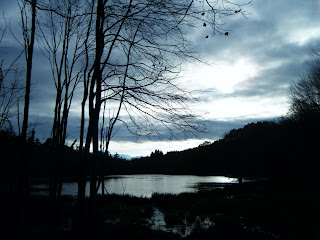 |
| Looking out from the haybarn |
 |
| Randy enjoying a Black Birch (Betula lenta) chew stick |
Several afternoons ago on a crisp autumn day, a friend and I ventured up to Zimmerman Farm just outside of Milford on Route 209. Parking the car at the bottom of an old carriage road, we walked only a short distance when the buildings came into view. On a small portion of this 1300 acre estate sits a stone house, stunning in its architecture with a short but stout steepled tower, large 4-paned windows with green shutters each adorned with a single cresecent moon, and a wide outdoor stairway and patio leading up to its back-of-the-house barn-style double doors. Surrounding this well-preserved home, built sometime in the early 1900's, are numerous outbuildings, a hay barn, and two smaller residences perhaps for family or farmhands.

Apple trees and unique ornamentals - unknown to me- can be seen lining old pathways, however, the landscape is largely overgrown. Blackberry and Barberry now dominate, along with a host of wild lettuces, tall grasses, and dried stalks of wintering plants. This landscape is probably abuzz with insect life in the spring and summer when blossoms are popping. Although now quiet and entering slumber, this earth still offered some bright plant life...
 |
| Yellow Foxglove (Digitalis grandiflora) |
 |
| Yellow Foxglove (Digitalis grandiflora) flowers up-close |
I found this plant growing in clumps not far from one of the secondary residences. Although Foxglove is not native to this area and often hybrized as an ornamental, I believe this to be one species that has long since naturalized in this region. The dried leaves of this plant have powerful glycosides called digoxin. You may recognize digoxin as a pharmaceutical used in regulating and strengthening the heart, though it does contain extracts from Foxglove, it is from a different species, D. lanata. This is a medicine to be respected and handled with great caution, as it can easily cross the line from therapeutic to deadly. Considering the host of safe herbal medicines for conditions of the heart, I would not recommend Foxglove as medicine.
 |
| Partridgeberry (Mitchella repens) |
Mitchella is a creeping evergreen vine, most often found trailing along the ground in Pine woods. In late spring and early summer it bears two 4-petaled white flowers at the end of its branches, by fall producing two edible (though tasteless) red berries. A fellow classmate once suggested cooking them up, adding lots of sugar and some pectin might produce a tasty jam. This plant is excellent for toning the tissues of the uterus, bladder and urethra. It can be helpful in bladder infections, interstitial cystitis, and urinary tract irritability, as well as protatitis. Historically it has also been used as a partice preperator, strengthening the uterus in preparation for childbirth. A tea can be made of the dried leaves, using 1teaspoon per cup of water or it can also be taken as a tincture, 2-5 dropperfuls three times day. This plant is on a "watch" list of potentially endangered plants, so if you must use it as medicine, please do so respectfully, taking only what you need and not uprooting.
 |
| Sheep Sorrel (Rumex acetosella) |
Finally, here is an easy plant to identify that can be gathered in abundance and easily enjoyed as a wild edible. Meet Sheep Sorrel (Rumex acetosella), a member of the buckwheat family (Polygonaceae). This plant can be found growing from between rocks, hugging the base of trees, throughout old farm fields, along the edges of roads, and anywhere soil seems thin and dry and available. Notice the two lobes at the base of each leaf, making it appear like a lamb's head with its ears sticking out to either side. It has a strong lemony flavor and makes a nice addition to salads, sandwiches and soups.
As we wandered further from the buildings, following the old carriage road as it wound up and around a steep hillside and into open woods, we paralleled stonewalls which led periodically into old clearings and crumbling foundations. We came to a swamp, the overflow of a nearby pond, catching a Bald Eagle as it flew between standing wood from dead trees whose bases had been gnawed away by resident beavers to the shape of hour-glasses. And with the sun beginning to dip below the treetops, we decided to call it a day, turning round and heading back to the farm. Thank you Zimmerman Farm.








No comments:
Post a Comment